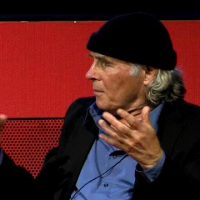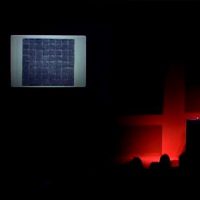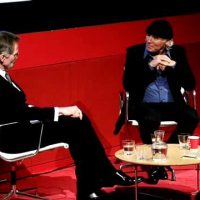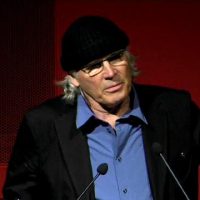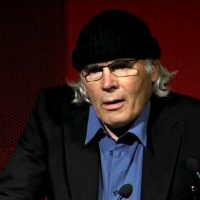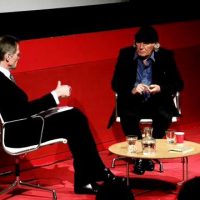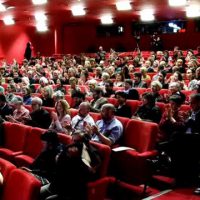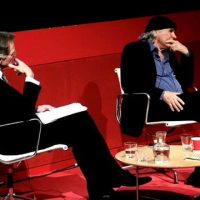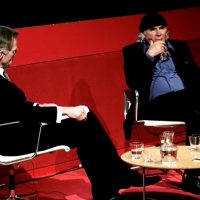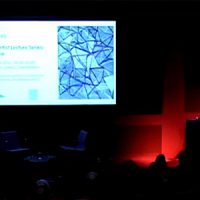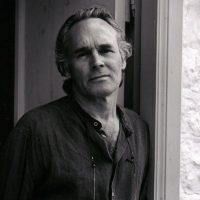Brice Marden participated in the AIE American Artist Lecture Series at the Tate Modern-London; a unique collaboration with Embassy London, in May of 2012. This partnership welcomes audiences of young artists and scholars in a lecture hall format. Designed as part lecture and part audience conversation, Brice spoke of his work, his inspirations, and his long regard for arts exchanges and dialogs.
Brice Marden received his MFA from the Yale School of Art and Architecture in 1963. He has been the subject of numerous one-man shows and retrospectives at such venues as the Solomon R. Guggenheim Museum, New York; The Museum of Modern Art, New York; and the San Francisco Museum of Modern Art. Marden is also a member of the American Academy of Arts and Letters and a longtime contributor to Art in Embassies.
Slide 1:
(music plays)
Embassy of the United States London · UK
Slide 2:
Brice Marden: “Pictures must be miraculous” Mark Rothko.
Slide 3:
Conversations with American Artists: Brice Marden
2: Mark Rothko’s “Orange and Tan”
Slide 4:
Marjorie Susman: All right, so here we have a marvelous Mark Rothko. What intrigues you about his work?
Marden: In Rothkos, the painter is unafraid of talking about the spiritual, the mystical, and so on. I have a lot of ideas about … they’re just incredibly beautiful paintings. You know, and…
Susman: They truly are.
Marden: I was just in Greece and every night we sat and watched the sunset and every night all this stuff would happen. And in certain places we’d go, we’d look over at the Rothko part because some part always seemed to be some variation from a Rothko painting—
Susman: Of this, of these colors—
Marden: Yeah. And I gave a talk to the Rothko chapel last year. The thing I came to realize in working on it is how in control he was of you know what he was making. Looking about it, thinking about it, doing all this research, looking at all the paintings he was doing at that time, what he went on to—there was no doubt in my mind that he knew exactly what he was doing and that he knew he had really nailed it. Susman: The fact that he always wanted his paintings hung with nobody else’s work, didn’t he, and white like gallery with only his paintings almost like it was a shrine almost like it was you know kind of a religious like he wanted it to be a religious experience looking at his paintings. I wonder what he would think if he saw it here.
(both laugh)
Marden: Well, one of the things he said, they asked him, what is your preferred viewing distance, and he said seven inches. So he would and you see lots of photographs of him standing really close, looking at his paintings. And so if you, so every time I get a chance, you know with a Rothko, I go and look at it from seven inches and it becomes this—
Susman: You’re absorbed into it. You are, you are.
Marden: Yeah. And it makes this sort of kind of it makes this sense of beyond being a picture and I’m and the abstract expressionists were very involved with that whole idea of not being pictorial, blah blah blah, but, you know, it really works.
Susman: Seven inches.
Marden: Okay.
Susman: It’s been fun to live with them, I must say. And to share them, to have them in a house not in a museum.
Marden: He was a real a real great painter.
(music plays)
Slide 5:
(music plays)
Brice Marden inaugurated the “American Artist Lecture Series” at London’s Tate Modern Museum, May 14, 2012.
Slide 6:
(music plays)
The Lecture Series is a collaboration between U.S. Embassy London, the Tate Modern, and the Department of State’s Office of ART in Embassies (AIE), in celebration of AIE’s 50 years of international cultural exchange.
Slide 7:
http://london.usembassy.gov
Slide 1:
(music plays)
Embassy of the United States London · UK
Slide 2:
Brice Marden: “The ultimate aim of painting is not decorative beauty but truth. What is truth? It must not be confused with formal resemblance. Indeed, formal resemblance only reaches the appearance of things whereas the function of truth is to capture their essence.”
Slide 3:
Conversations with American Artists: Brice Marden
1: Brice Marden’s “Untitled No. 3”
Slide 4:
Susman: The ambassador and I are really great lovers of passionate about art and are art collectors ourselves and so as soon as he was appointed we had this idea of filling beautiful Winfield, historic Winfield House with great American modern and contemporary paintings. We went to work immediately, I got together with Art in Embassy and worked with them, but also called friends that I had that were museum directors or art collectors and the first thing I grabbed, Brice, was your painting. And I have wondered, ever since it went up, what would Brice Marden think if he saw it in this room. (laughs) And I’ve got you! I’ve got you, so I have to start there.
Marden: Certainly wasn’t expecting this. It was sort of one of the first really completed one of this group of paintings which is like the first group after really making a big change in my work. And you know I was just really concerned about getting the painting finished. You know what I mean? It’s just, you’re working on this project and you don’t know whether it’s going to work at all. And this was the first one and it really sort of gets you a little bit by surprise. You’re working on it and you walk in the studio one day and you go, oh, it’s finished.
Susman: Yeah, fantastic. And that’s how it happens?
Marden: Yeah. Well, that’s how it happened with this one.
Susman: It’s quite a change from those earlier works.
Marden: Oh yeah, those monochromatic—
Susman: Monochromatic paintings that were so elegant, so endlessly beautiful. The panels, the diptychs, the triptychs.
Marden: Well, I just kind of stopped doing them. You start out as sort of a radical but you stay around long enough, you know, you become quite conservative. And there’s also the thing where you have to keep watching out that what at one point was a kind of discovery can turn into a cliché, your own cliché. So there’s always—
Susman: Interesting. So this here, this was—
Marden: What gave birth to this kind of—yeah.
Susman: I understand that with some of your new paintings that you’re once again doing some of the panels but in a new way.
Marden: I hit a certain point, you know. It wasn’t a crisis. It was, um, my brother died and rather unexpected and so suddenly this whole thing of mortality comes in. You think, oh what are you doing, you’re just. So I figured, buckle down and really work harder because there’s a lot I want to get done before that happens to me. And then there were like these weird little projects and I’m thinking I can you know I can do whatever I want, there’s always, that’s one of the reasons you become an artist because nobody tells you what to do, you just do it. I’m doing a little bit more of that, have a lot of funny little projects. And some of them, I’ve gone back to drawings I started but never finished you know 20 years ago, trying to finish them up. But now I can do whatever I want to do, so that’s what I’m doing. (music plays)
Slide 5:
(music plays)
Brice Marden inaugurated the “American Artist Lecture Series” at London’s Tate Modern Museum, May 14, 2012.
Slide 6:
(music plays)
The Lecture Series is a collaboration between U.S. Embassy London, the Tate Modern, and the Department of State’s Office of ART in Embassies (AIE), in celebration of AIE’s 50 years of international cultural exchange.
Slide 7:
http://london.usembassy.gov
Slide 1:
Text: Front Row Interview with Brice Marden
Voiceover: From the likes of Jasper Johns, Andy Warhol and Robert Rauschenberg, Brice Marden emerged as one of the stars of the New York art scene of the early 1960s. Unlike many of his pop peers of the time, Marden made his name with abstract works, in particular large, austere monochrome paintings. Five decades on and those who made their art in derelict warehouses are now hung in national galleries and collected by billionaires. Last night, Brice Marden delivered a lecture at the Tate Modern, part of the Art in Embassies program organized by the American government. This morning I met him at the official residence of the U.S. ambassador where Brice Mardens hang alongside Warhols and Rothkos. He told me about the inspiration behind those early monochrome paintings.
Marden: The first monochromatic paintings I made, I had just returned from Paris. And they were cleaning up Paris and I would spend hours watching them re-stuccoing walls. Start at the top, work down to the bottom, there would be this accumulation of splashes at the bottom. I came back to New York, I was painting, I was trying to make grid paintings and they never quite were working so I would paint out half of it and one night I just painted the whole thing out and I had a monochromatic painting. And it’s related to the walls that I was watching them—I mean, you’d see them working this, so you’d know that there was like this physical involvement, and then you’re thinking, you know, is this valid? Is this a picture?
Interviewer: But you say there you were interested in the physicality, you were looking at these men painting on a large scale and thinking back to that time when you emerged and those kind of artists that you were working alongside in New York, the work of Jasper Johns and Rauschenberg and Rothko and a lot of people, there was a lot of physical of physicality to the painting that was happening at the time, wasn’t there?
Marden: Well yeah, but all of those guys, you weren’t working with them, they were like the—
Interviewer: No, but there was a shared aesthetic (laughter) among all those very different painters, different artists.
Marden: There was a shared aesthetic, but you were trying to set up your own aesthetic. And Jasper was a huge influence on my work, you know. I was a guard at the Jewish Museum, I was guarding the Jasper Johns retrospective. I was in the room with the big white painting all day long and with all his all these earlier works so I really knew the work. It was real. I’m not considering it as pop art, it was realism. And I thought what I was making was just as real but it didn’t represent anything.
Interviewer: But let me take you back to being a guard at the Jewish Museum and sitting in that room for hours on end with Jasper Johns paintings—
Marden: I had to stand (laughs) You didn’t sit, you had to stand.
Interviewer: Did you know him, did you get to know him?
Marden: He came in one day and he was cleaning the white flag, started dusting it off. But you know you don’t just like walk up and chat with Jasper. (laughs) You know? I mean, I was quite intimidated.
Interviewer: But you got to know because you were working for Robert Rauschenberg so was he, again, very different artist, what did you learn from him as his studio assistant?
Marden: Well, Rauschenberg was just brilliant. I’d come in in the morning and make coffee, you know, cleaning up after the dogs.
Interviewer: You didn’t actually sit down and make art together, you didn’t help him—
Marden: I worked on one… my job basically was to make it to have everything the way that he needed it to make stuff. An d he usually worked at night and I worked during the day. But there is this thing that’s kind of a tradition you know where you’re doing okay, you hire younger artists to work for you and it’s just good for them to be around the stuff. It’s not that you’re teaching them or anything, it’s not the apprentice system.
Interviewer: Of course you then had success, you had acclaim, you had your own shows, you made your mark and people associated you with those big dramatic monochrome paintings. And then there was a very dramatic change in your style and you had the cold mountains series of paintings which were more gestural, free flowing, series of lines on canvas, again monumental in size. That was influenced by Chinese calligraphy, then?
Marden: Yeah, yeah. Because I’d been trying to get more drawing into the painting. And it had to do with you’re making a monochromatic panel and I was drawing very severe straight strokes with I use a big sort of pallet knife, it was like a cooking spatula. It just wasn’t reading, and I wanted more drawing in the painting. And the calligraphy was a way to do that and I just had to figure out how to do it. And this was from the first show that I had with Mary after I went through that change.
Interviewer: Now you’re pointing to a painting on the wall. We’re sitting in Winfield House, which is the American ambassador’s residence, and we’re sitting here with Marjorie Susman who is the ambassador’s wife who curates the art in this house and there are a lot of artists, American artists, great names, and your painting, the one that you’re pointing to, is hanging here in the state dining room. So this is an early example of the cold mountain series. First of all, could you have imagined when you were first painting, scratching around in lofts in New York, several decades ago, that your painting would be hanging here in the American ambassador’s residence?
Marden: No, not really (laughs). Well, you have these sort of things, well, what could happen, but you know, you don’t plan on it (laughs).
Interviewer: But proud that it is here?
Marden: Oh this is great! Proud, you can’t get proud, it’s dangerous—
Interviewer: Pride is dangerous.
Marden: But no, I never would have expected this and I’m very happy that it’s here. Interviewer: This is Marjorie Susman. This is one of your favorite paintings, isn’t it, it hangs—
Susman: It’s one of my favorite paintings from one of my favorite artists, so I am proud that it is hanging here. We put this collection, the whole collection together with the Art in Embassy program of the State Department, with pressure on some of my special friends to help and one, a woman named Agnes Gund, said come to my house and take whatever you want, and I took four pieces and the first thing I grabbed was this Brice Marden painting. And it was probably bold to put it here, I think one of the things I worried most about was what would Brice Marden think if he saw his painting hanging in this room with all this gilt paint and crystal chandeliers—
Interviewer: Well we should just set the scene because there is exactly the gilt lining everywhere. A beautiful long, what is this a mahogany table?
Susman: Right.
Interviewer: Very long, with about eight chairs at either side, carpeted. And the first thing to say about the painting is it does chime with the color scheme in here because predominantly there are muted greens some grays and some red lines within those geometric predominantly triangles that Brice Marden has created on there. But that’s really the only thing that chimes with the style, isn’t it?
Susman: Well, actually, it had nothing to do with the color, I guess these gray blue walls they were here and there was no changing them. But I think the great moment for me was when we hosted a return state dinner, a state dinner for the Queen, Her Majesty the Queen, when President Obama and Mrs. Obama were here visiting. They were all dining under this magnificent Brice Marden painting. And it was just an incredible moment for me.
Interviewer: We should ask Brice what he thinks about this, because you weren’t here to share this moment were you, your painting was, you were represented by your work. Did you know about that, have you heard that story?
Marden: I heard, Matthew told me, my dealer told me about it. You know, this kind of political power, this financial power, because also art has power. Quite often you get the financial system, the political system, really tries to negate the power of art. And it’s really great to have a painting in some sort of position where it’s allowed to try to do its work.
Interviewer: So sitting in this room you’ve had presidents, prime ministers, heads of state— Marden: Yeah I don’t think anybody went home and said “I’m going to change the world” (laughs) Interviewer: But they couldn’t avoid it, though, they couldn’t ignore it.
